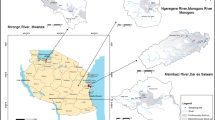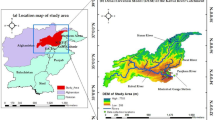Abstract
Urban runoff is an effective alternative water resource, particularly in arid and semi-arid regions. Urban runoff exploitation permits cities to have a significant amount of water, but without assessing the runoff quality, harvesting of this resource is complicated and requires further investigations. Due to the lack of a specific method, in this study, a new index method (WLTR) was developed for assessing the urban runoff vulnerability to contamination. The WLTR index is based on rating different sub-factors of wastewater (W), land use (L), transportation (T), and rainfall runoff (R) factors. The efficiency of the WLTR index was investigated in 12 sub-catchments of the Ardabil city in Iran. The priority of sub-catchment vulnerability was determined via WLTR index value. The efficiency of the developed method was investigated using direct measurement of several water quality parameters (pH, EC, TDS, TSS, TH, and SO4) in the sub-catchments outlet. A Water Quality Index (WQI) was calculated for each sub-catchment. The quality priority of sub-catchments was determined based on the WQI value. According to the measured data, an acceptable efficiency was observed for WLTR index. According to the results, the most vulnerable sub-catchments (Nos. 4, 11, and 12) had the lower runoff quality among studied sub-catchments, whereas the least vulnerable sub-catchments (Nos. 2, 9, and 8) had the higher runoff quality.


Similar content being viewed by others
References
Althuwaynee OF, Pradhan B, Park HJ, Lee JH (2014) A novel ensemble bivariate statistical evidential belief function with knowledge-based analytical hierarchy process and multivariate statistical logistic regression for landslide susceptibility mapping. Catena 114:21–36
Angrill S, Petit-Boix A, Morales-Pinzon T, Josa A, Rieradevall J, Gabarrell X (2017) Urban rainwater runoff quantity and quality - a potential endogenous resource in cities. J Environ Manag 189:14–21
Antunes LN, Thives LP, Ghisi E (2016) Potential for potable water savings in buildings by using stormwater harvested from porous pavements. Water 8(4):1–18
Bartlett, J. H. (2016). Impacts of transportation infrastructure on storme water and surface waters in Chittenden County, Vermont, USA. Thesis for Master of Science, Faculty of the Graduate College, University of Vermont
Batabyal AK, Chakraborty S (2015) Hydrogeochemistry and water quality index in the assessment of groundwater quality for drinking uses. water Environ. Res. 87(7):607–617
Behera PK, Adams BJ, Li JY (2006) Runoff quality analysis of urban catchments with analytical probabilistic models. J Water Resour Plan Manag 132(1):4–14
Boyd G, Gardner N (1990) Urban stormwater: an overview for municipalities. Public Works, December, 39–42
Brown RM, Mcclelland NI, Deininger RA, Tozer RG (1970) A water quality index: do we dare? Water Sewage Works 117:339–343
Chandio IA, Matori ANB, WanYusof KB, Talpur MAH, Balogun AL, Lawal DU (2013) GIS-based analytic hierarchy process as a multicriteria decision analysis instrument: a review. Arab J Geosci 6(8):3059–3066
Chatterjee C, Raziuddin M (2002) Determination of water qualti index (WQI) of a degraded river in Asanol Industrial area, Raniganj, Burdwan, West Bengal. Nature Environ and Pollution Technol 1(2):181–189
Chen J, Adams BJ (2007) Development of analytical models for estimation of urban stormwater runoff. J Hydrol 336:458–469
Chevre N, Vallotton N, Rossi L (2007) Risk assessment of urban runoff pollution in rivers: how to deal with time-varying concentrations? NOVATECH 2007 - Sixth International Conference on Sustainable Techniques and Strategies in Urban Water Management, Lyon
Chui TW, Mar BW, Hornet RR (1982) A pollutant loading model for highway runoff. J Environ Engi 108(6):1193–1210
Ding J, Jiang Y, Fu L, Liu Q, Peng Q, Kang M (2015) Impacts of land use on surface water quality in a subtropical river basin: a case study of the Dongjiang river basin, southeastern China. Water 7:4427–4445
Eimers JL, Weaver JC, Terziotti S, Midgette RVW (2000) Methods of rating unsaturated zone and watershed characteristics of public water supplies in north carolina, U.S. Geological Survey Water-Resources Investigations Report 99–4283
EPA (1999) Preliminary Data Summary of Urban Stormwater Best Management Practices, U.S.
Fan R, Tong STY, Lee JG (2017) Determining the optimal BMP arrangement under current and future climate regimes: case study. J Water Resour Plan Manag 143 (9):1–16
Fletcher TD, Deletic A, Mitchell VG, Hatt BE (2008) Reuse of urban runoff in Australia: a review of recent advances and remaining challenges. J Environ Qual 37(5):116–127
Freni G, Mannina G, Viviani G (2010) Urban storm-water quality management: centralized versus source control. J Water Resour Plan Manag 136:268–278
Ghazavi R, Ebrahimi Z (2015) Assessing groundwater vulnerability to contamination in an arid environment using DRASTIC and GOD models. Int J Environ Sci Technol 12:2909–2918
Ghodsi SH, Kerachian R, Zahmatkesh Z (2016a) A multi-stakeholder framework for urban runoff quality management: application of social choice and bargaining techniques. Sci Total Environ 550:574–585
Ghodsi SH, Kerachian R, Malakpour Estalaki S, Nikoo MR, Zahmatkesh Z (2016b) Developing a stochastic conflict resolution model for urban runoff quality management: application of info-gap and bargaining theories. J Hydrol 533:200–212
Harbaugh AW, Banta ER, Hill MC, Mcdonald MG (2001) MODFLOW-2000, the US Geological Survey modular ground-water model users guide to modularization concepts and the groundwater flow process, U.S. Geological Survey open-file report 00–92
Harum T, Saccon P, Calasans N, Ruch C h (2004) Water resources, vulnerability assessment and quality of water in Cachoeira Catchment. ECOMAN Newsletter 3:1–8
Hilpert M, Mora BA, Ni J, Rule AM, Nachman KE (2015) Hydrocarbon release during fuel storage and transfer at gas stations: environmental and health effects. Current Environ. Health Rep 2(4):412–422
Hur S, Nam K, Kim J, Kwak C (2018) Development of urban runoff model FFC-QUAL for first-flush water-quality analysis in urban drainage basins. J. Environ, Manage. 205:73–84
Jia H, Ma H, Sun Z, Yu S, Ding Y, Liang Y (2014) A closed urban scenic river system using stormwater treated with LID-BMP technology in a revitalized historical district in China. Ecological Engin 71:448–457
Kang J, Lee SW, Cho KH, Ki SJ, Cha SM, Kim JH (2010) Linking land-use type and stream water quality using spatial data of fecal indicator bacteria and heavy metals in the Yeongsan riverbasin. Water Res 44:4143–4157
Lee JH, Bang KW (2000) Characterization of urban stormwater runoff. Water Res 34(6):1773–1780
Lehner P H, Aponte Clarke GP, Cameron DM, Frank AG (1999) Stormwater strategies: community responses to runoff pollution. Natural Resources Defense Council, New York, p 269
Li D, Wan J, Ma Y, Wang Y, Huang M, Chen Y (2015) Storm water runoff pollutant loading distributions and their correlation with rainfall and catchment characteristics in a rapidly industrialized city. PLoS One 10(3):e0118776
Liu A, Egodawatta P, Guan Y, Goonetilleke A (2013) Influence of rainfall and catchment characteristics on urban stormwater quality. Sci Total Environ 444:255–262
Maharjan B, Pachel K, Loigu E (2017) Modelling stormwater runoff, quality, and pollutant loads in a large urban catchment. Proceedings of the Estonian Academy of Sci 66(3):225–242
Mallin MA (2013) Septic systems in the coastal environment: multiple water quality problems in many areas. Monitoring Water Quality 2013:81–102
Margaryan L (2016) Impact of domestic wastewater on surface water quality of selected residential settlements in Armenia. European Water 53:5–12
Mays L (2009) Integrated urban water management: arid and semi-arid regions. UNESCOIHP, CRC Press, Taylor & Francis Group, Boca Raton, London, New York
McDowell W, Brick Ch, Clifford M, Frode-Hutchins M, Harvala J, Knudsen K (2005) Septic system impact on surface waters: a review for the inland northwest. Tri-State Water Quality Council
McPhearson T, Hamstead ZA, Kremer P (2014) Urban ecosystem services for resilience planning and management in New York City. AMBIO 43(4):502–515
National Research Council (1993) Ground water vulnerability assessment, predicting relative contamination potential under conditions of uncertainty. National academy press, washington
Nosrati K (2017) Identification of a water quality indicator for urban roof runoff. Sustain. Water Quality Ecology 9-10:78–87
Paule MA, Memon SA, Lee BY, Umer SR, Lee CH (2014) Stormwater runoff quality in correlation to land use and land cover development in Yongin, South Korea. Water Sci Technol 70(2):218–225
Pourghasemi HR, Moradi HR, Fatemi Aghdam SM, Gokceoglu C, Pradhan B (2012) GIS-based landslide susceptibility mapping with probabilistic likelihood ratio and spatial multi criteria evaluation models (north of Tehran, Iran). Arab J Geosci 7(5):1857–1878
Richardson CP, Tripp GA (2006) Investigation of boundary shear stress and pollutant detachment from impervious surface during simulated urban storm runoff. J Environ Eng 132(1):85–92
Saatsaz M, Sulaiman WNA, Eslamian S (2011) GIS DRASTIC model for groundwater vulnerability estimation of Astaneh-Kouchesfahan Plain, Northern Iran. Int J Water 6(1/2):1–14
Saaty TL (1980) The analytical hierarchy process, pinning priority, resource allocation. RWS, U.S
Saaty TL (1986) Axiomatic Foundation of Analytical Hierarchy Process. Manag Sci 31(7):841–855
Schaider LA, Ackerman JM, Rudel RA (2016) Septic systems as sources of organic wastewater compounds in domestic drinking water wells in a shallow sand and gravel aquifer. Sci Tot Environ 547:470–481
Shah Naqvi SAA, Sultan A, Eslamian S (2015) Water Quality Issues in Urban Water, in Urban Water Reuse Handbook, Ch. 8, Ed. By Eslamian, S., CRC, U.S.
Taebi A, Droste RL (2004) Pollution loads in urban runoff and sanitary wastewater. Sci. of the Tot. Environ. 1(3):175–184
Taffere GR, Beyene A, Vuai SAH, Gasana J, Seleshi Y (2016) Reliability analysis of roof rainwater harvesting systems in a semi-arid region of sub-Saharan Africa: case study of Mekelle, Ethiopia. Hydrol Sci J 61(6):1135–1140
Tsihrintzis VA, Hamid R (1997) Modeling and management of urban stormwater runoff quality: a review. Water Resour Manag 11:137–164
UN (United Nations) (2012) World Urbanization Prospects: the 2012 Revision. New York
Van Roon M (2007) Water localisation and reclamation: steps towards low impact urban design and development. J Environ Manag 83:437–447
WHO (World Health Organization) (2006) Guidelines for drinking-water quality, 3rd ed.
Yang J, Wang ZH, Chen F, Miao S, Tewari M, Voogt J, Myint S (2015) Enhancing hydrologic modelling in the coupled Weather Research and Forecasting–urban modelling system. Bound-Layer Meteorol 155: 87–109
Yogendra K, Puttaiah ET (2007) Determination of water quality index and suitability of an urban waterbody in Shimoga Town, Karnataka. the 12th world lake conference 2007, ILCE, Jaipur, 342–346
Young KD, Dymond RL, Kibler DF (2011) Development of an improved approach for selecting storm-water best management practices. J Water Resour Plan Manag 137:268–275
Zhang B, Xie GD, Zhang CQ, Zhang J (2012) The economic benefits of rain water-runoff reduction by urban green spaces:A casestudy in Beijing,China. J Environ Manage 100:65–71
Zhou J, He Z, Yang Y, Deng Y, Tringe SG, Alvarez-Cohen L (2015) High-throughput metagenomic technologies for complex microbial community analysis: open and closed formats. mBio 6(1). https://doi.org/10.1128/mBio.02288-14
Zhou Q, Blohm A, Liu B (2017) Planning framework for mesolevel optimization of urban runoff control schemes. J Water Resour Plan Manag 143(4):1–11
Zhu K, Zhang L, Hart W, Liu M, Chen H (2004) Quality issues in harvested rainwater in arid and semi-arid Loess Plateau of northern China. J Arid Environ 57:487–505
Author information
Authors and Affiliations
Corresponding author
Additional information
Responsible Editor: Amjad Kallel
Rights and permissions
About this article
Cite this article
Ghazavi, R., Imani, R. & Esmali ouri, A. Development and application of a new index-overlay method to assess urban runoff vulnerability to contamination (evaluation in the Ardabil city, Iran). Arab J Geosci 13, 1119 (2020). https://doi.org/10.1007/s12517-020-06121-z
Received:
Accepted:
Published:
DOI: https://doi.org/10.1007/s12517-020-06121-z




